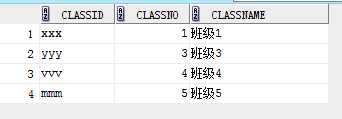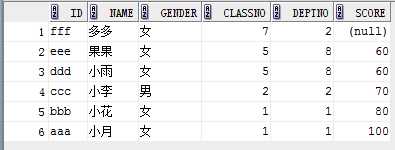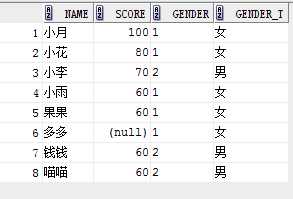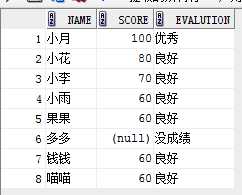ORACLE 常用sql用法和及註意事項
1.exits和in用法
1)說明:
1. exists對外表做循環,每次循環對內表查詢;in將內表和外表做hash連接
2. 使用exists oracle會先檢查主查詢; 使用in,首先執行子查詢,並將結果存儲在臨時表中
2)使用:
表class和student表


下面查詢student中classno在class中的數據
1. 使用exists和not exists
select name, classno from student where exists (select * from class where student.classno= class.classno);
結果:

select name, classno from student where not exists (select * from class where student.classno= class.classno);
結果:

select name, classno from student where classno in (select classno from class);
2. 使用in 和not in
select name, classno from student where classno not in (select classno from class);

結果:

3)比較
1. 如果兩個表大小相當,in和exists差別不大
2. 如果兩個表大小相差較大則子查詢表大的用exists,子查詢表小的用in
3.盡量不要使用not in
2.union和union all
1)說明:
1. 使用場景:需要將兩個select語句結果整體顯示時,可以使用union和union all
2. union對兩個結果集取並集不包含重復結果同時進行默認規則的排序;而union all對兩個結果集去並集,包括重復行,不進行排序
3. union需要進行重復值掃描,效率低,如果沒有要刪除重復行,應該使用union all
4. insersect和minus分別交集和差集,都不包括重復行,並且進行默認規則的排序
2)使用註意事項
1.可以將多個結果集合並
2. 必須保證select集合的結果有相同個數的列,並且每個列的類型是一樣的(列名不一定要相同,會默認將第一個結果的列名作為結果集的列名)
3)例子:
表student

eg1:
select name, score from student where score> 60
union all
select name, score from student where score <200;
結果:(有重復,沒有排序)

select name, score from student where score> 60
union
select name, score from student where score <200;
結果:(沒有重復,並且排序了)

3.with as
1)說明:
1. with table as 可以建立臨時表,一次分析,多次使用
2. 對於復雜查詢,使用with table as可以抽取公共查詢部分,多次查詢時可以提高效率
3. 增強了易讀性
2)語法:
with tabName as (select ...)
3)例子:
表student

eg1:
select rownum, name, score from (select rownum, name,score from student where score >70 order by score);
可以更換成:
with table_s as (select rownum, name,score from student where score >70 order by score)
select name, score from table_s;
結果:

4)多個with table as 一起使用時用逗號隔開,並且只能使用一個with如下例子
eg1:
with vt1 as (select * from student where score >=60),
vt2 as (select * from class),
vt3 as (select * from teacher)
select vt1.name, vt1.score, vt2.classname, vt3.teachername from vt1,vt2,vt3 where vt1.classno= vt2.classno and vt1.teacherid=vt3.teacherid;
eg2:

with vt as (select t.*
from travelrecord t where t.starttime>=to_date(‘2014-02-01‘,‘yyyy-mm-dd‘) and t.endtime<=to_date(‘2014-04-30‘,‘yyyy-mm-dd‘)+1 and to_char(starttime,‘hh24‘)>=‘08‘ and to_char(endtime,‘hh24‘)<=‘11‘ and t.vehiclenum=‘100088110000‘),
vt1 as (select sum(vt4.traveltime) as stoptime from ((select * from vt where vt.state=‘0‘)vt4)),
vt2 as (select sum(vt.traveltime)as "ONLINETIME1",sum(vt.distance)as "DISTANCE1"from vt)
select vt1.stoptime,vt2.distance1, vt2.onlinetime1 from vt2, vt1;

4. order by
1)說明:
1. order by 決定oracle如何將查詢結果排序
2. 不指定asc或者desc時默認asc
2)使用:
1. 單列升序(可以去掉asc)
select * from student order by score asc;
2. 多列升序
select * from student order by score, deptno;

3. 多列降序
select * from student order by score desc, deptno desc;
4. 混合
select * from student order by score asc, deptno desc;
3)對NULL的處理
1. oracle在order by 時認為null是最大值,asc時排在最後,desc時排在最前
eg:
select * from student order by score asc;
結果:
2. 使用nulls first (不管asc或者desc,null記錄排在最前)或者nulls last 可以控制null的位置,eg:
select * from student order by score asc nulls first;
結果如下:

4)將某行數據置頂(decode)
eg1:
select * from student order by decode(score,100,1,2);
結果:

eg2: (某一行置頂,其他的升序)
select * from student order by decode(score,100,1,2), score;

5)註意事項
1. 任何在order by 語句的非索引項都將降低查詢速度
2. 避免在order by 子句中使用表達式
5. group by
1)說明:
1.用於對where執行結果進行分組
2)簡單例子:
eg1:

select sum(score), deptno from student group by deptno;
結果:

eg2:
select deptno,sum(score) from student where deptno>1 group by deptno;
結果:

6.where和having
1)說明:
1. where和having都是用來篩選數據,但是執行的順序不同 where --group by--having(即分組計算前計算where語句,分組計算後計算having‘語句),詳情查看章節一sql執行順序
2. having一般用來對分組後的數據進行篩選
3. where中不能使用聚組函數如sum,count,max等
2)例子:
eg1: 對 5 中group by 的數據篩選
select deptno,sum(score) from student where deptno>1 group by deptno having sum(score)>100;
結果:

7. case when 和decode
1)說明:
1. decode更簡潔
2. decode只能做等值的條件區分,case when可以使用區間的做判斷
2)語法:

decode(條件,值1,返回值1,值2,返回值2,...值n,返回值n,缺省值)
--等價於:
IF 條件=值1 THEN
RETURN(翻譯值1)
ELSIF 條件=值2 THEN
RETURN(翻譯值2)
......
ELSIF 條件=值n THEN
RETURN(翻譯值n)
ELSE
RETURN(缺省值)
END IF

CASE expr WHEN comparison_expr1 THEN return_expr1
[WHEN comparison_expr2 THEN return_expr2
WHEN comparison_exprn THEN return_exprn
ELSE else_expr]
END

CASE
WHEN comparison_expr1 THEN return_expr1
[WHEN comparison_expr2 THEN return_expr2
WHEN comparison_exprn THEN return_exprn
ELSE else_expr]
END

3)例子:
eg1:
方式一:

select name, score,gender,
case gender when ‘1‘ then ‘女‘
when ‘2‘ then ‘男‘
else ‘未說明‘
end gender_t
from student;

方式二:

select name, score,gender,
case when gender=‘1‘ then ‘女‘
when gender=‘2‘ then ‘男‘
else ‘未說明‘
end gender_t
from student;

方式三:
select name,gender,decode(gender,‘1‘,‘女‘,‘2‘,‘男‘,‘未說明‘)gender_t from student;
結果:

eg2:

select name,score,
case when score >80 then‘優秀‘
when score>=60 and score <=80 then ‘良好‘
when score<60 then ‘不及格‘
end evalution
from student;

結果:

設置默認值,將null置為沒成績:

select name,score,
case when score >80 then‘優秀‘
when score>=60 and score <=80 then ‘良好‘
when score<60 then ‘不及格‘
else ‘沒成績‘
end evalution
from student;

結果:

4)註意:
1.case有兩種形式,其中case 表達式 when then方式效率高於case when 表達式效率
2.使用decode函數可以避免重復掃描相同記錄或者重復連接相同的表,因而某些情況可以減少處理時間
SQL 優化總結
1. SQL優化一般性原則
1)目標:減少服務器資源消耗(主要是磁盤IO)
2)設計:
1. 盡量依賴oracle優化器
2. 合適的索引(數據重復量大的列不要簡歷二叉樹索引,可以使用位圖索引; 對應數據操作頻繁的表,索引需要定期重建,減少失效的索引和碎片)
3)編碼:
1.利用索引
2. 合理利用臨時表
3. 避免寫過於復雜的sql;
4. 盡量減小事務的粒度
2. 具體註意事項
1)查詢時盡量使用確定的列名
2)盡量少使用嵌套的子查詢,這種查詢很消耗cpu資源
3)多表查詢的時候,選擇最有效率的表名順序
oracle解析器對表的處理順序從右到左,所以記錄少的表放在右邊(最右邊的表為基礎表,drivering table最先被處理), 如果3個以上的表連接查詢,則要選擇交叉表作為基礎表
4)or比較多時分為多個查詢,使用union all(盡量用union all代替union)聯結(適應於索引列)
詳細見上一章節union和union all
5) 盡量多用commit提交事務,可以及時釋放資源、解鎖、釋放日誌
6)訪問頻繁的表可以放置在內存中
7)避免復雜的多表關聯
8)避免distinct,union(並集),minus(差集),intersect(交集),order by等耗費資源的操作,因為會執行耗費資源的排序功能
9)使用exists替代distinct
ORACLE 常用sql用法和及註意事項
